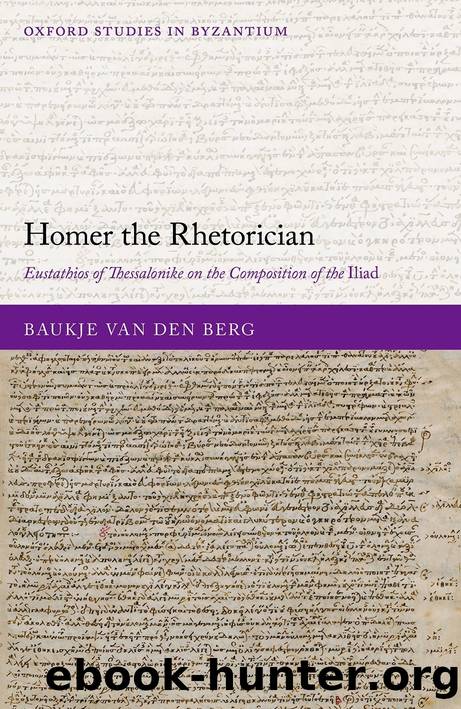Homer the Rhetorician: Eustathios of Thessalonike on the Composition of the Iliad by Baukje van den Berg;

Author:Baukje van den Berg; [van den Berg, Baukje]
Language: eng
Format: epub
ISBN: 9780192689085
Publisher: OxfordUP
Published: 2022-05-26T00:00:00+00:00
Enargeia and the Graphic Quality of Homerâs Style
Closely related to the plausibility and âsafetyâ of Homerâs formulation is Eustathiosâ notion of enargeia. Modern scholarship has devoted much attention to enargeia in ancient criticism, which a recent study summarizes as âthe mental state of a reader or listener who experiences the illusion of being âpresentâ at the events and characters of the narrative [â¦] the distance between narrative world and narratees is collapsedâ.117 In other words, enargeia is the quality of a narrative that gives the audience the impression that they are witnessing the narrated situation and allows them to see the events and characters in their mindâs eye. The scholia vetera repeatedly recognize such enargeia in Homeric poetry and explain how Homerâs words enable the audience to visualize the narrated events.118 Eustathios also uses the notion of enargeia in his analysis of Homer, yet his usage of the term is in line with most middle Byzantine writing, where â[t]he word itself and cognate terms do not refer to representational vividness, but, they denote truth behind and beyond any aesthetic representation, whether discursive or visualâ.119 Enargeia in Eustathios would therefore best be translated as âself-evidenceâ:120 the enargeia of Homerâs style ensures that the narrated events are absolutely clear to the audience in their every detail. It makes their discursive representation unambiguous and evident beyond question.
While Eustathiosâ notion of enargeia is in line with Byzantine usage of the term, the techniques he identifies as producing enargeia have much in common with those of ancient critics and rhetoricians. His conception of enargeia is thus a case in point of the appropriation of ancient concepts within a Byzantine framework that characterizes Eustathiosâ Homeric project in general. Throughout the Commentary on the Iliad, Eustathios identifies repetition,121 onomatopoeia,122 ekphrasis,123 the specification of circumstantial detail,124 and similes125 as particularly productive of enargeia. The underlying idea seems to be that with these techniques the poet makes the audience understand the narrated events as clearly as possible. In Eustathiosâ view, Homerâs discussion of the destruction of the Greek wall is such an event that is narrated with much enargeia. He explains how Homer refers to the future destruction in both Iliad 7 and 12. By addressing most of the elements of narrative (person, manner, cause, time, and event), the account in Iliad 12 specifies exactly how the destruction will happen with clarity and enargeia.126
Throughout the Commentary on the Iliad, enargeia is most often connected with Homeric similes,127 a connection also found in the scholia vetera.128 Whereas the scholia define enargeia in terms of vividness and graphic style, for Eustathios similes enhance the enargeia qua clarity and specificity of the narrative. In his view, similes make clear exactly how we are to understand the narrated eventsâthat is why, we may recall, the images used in similes should be familiar to the audience.129 A simile in Iliad 21 may serve as an example. After his battle with Hephaestus, the river Xanthus spoke âburning with fire, and his fair streams were seethingâ (Il.
Download
This site does not store any files on its server. We only index and link to content provided by other sites. Please contact the content providers to delete copyright contents if any and email us, we'll remove relevant links or contents immediately.
The European History Highway: A Guide to Internet Resources by Dennis A. Trinkle Scott A. Merriman(492)
The Seven Wonders of the Ancient World by Michael Denis Higgins(475)
European Security without the Soviet Union by Stuart Croft Phil Williams(468)
European Security in a Global Context by Thierry Tardy(466)
The Routledge companion to Christian ethics by D. Stephen Long Rebekah L. Miles(456)
Hudud Al-'Alam 'The Regions of the World' - a Persian Geography 372 A.H. (982 AD) by V. V. Minorsky & C. E. Bosworth(398)
Gorbachev And His Generals by William C. Green(390)
Get Real with Storytime by Julie Dietzel-Glair & Marianne Crandall Follis(388)
Tibetan Studies in Comparative Perspective by Chih-yu Shih Yu-Wen Chen(385)
Governance, Growth and Global Leadership by Espen Moe(380)
Hyperculture by Byung-Chul Han(374)
CliffsNotes on Fitzgerald's The Great Gatsby by Kate Maurer(359)
The Oxford History of the World by Fernández-Armesto Felipe;(353)
How Languages Are Learned 5th Edition by Patsy M Lightbown;Nina Spada; & Nina Spada(352)
The Egyptian Economy, 1952-2000 by Khalid Ikram(348)
Oral Poetry and Narratives from Central Arabia: The Poetry of Ad-Dindan : A Bedouin Bard in Southern Najd (Studies in Arabic Literature, Vol 17) (English and Arabic Edition) by P. M. Kupershoek P. Marcel Kurpershoek(340)
The Oxford Handbook of the Incas by Sonia Alconini(333)
Europe Contested by Harold James(319)
The Hutchinson Dictionary of Ancient and Medieval Warfare by Peter Connolly John Gillingham John Lazenby(303)
